| 300ZX TT Safety Boost Experience Much has been made of the 300ZX TT car’s safety boost system (not an official system name by Nissan but used here because everyone uses it). Usually the post starts out something like: OMG I think that I am in safety boost. I am only getting 6-7 lbs of boost when I should be getting the full 9+ lbs. What do I do? The responses to these posts usually list a few things to check and failing that then a long list of engine operation sensors and systems that the ECU may or may not use as inputs to the ECU to decide whether to put the car in a restricted boost situation or allow full boost of 9lbs. Finally some go so far as to suggest bypassing the detonation sensor. I fell into this trap myself. I was only reading 7 lbs boost according to my dash boost so I figured that I must be in a safety boost condition too. I performed exhaustive tests on all my sensors and wiring and this is what I determined: 1. Before you dig into the engine to look for possible problems, first verify that you are actually in a safety boost condition. You do this by hooking up a “real” vacuum gauge with a large scale on it to the engine. If you do this you may find as I did that the factory boost gauge is too small and too inaccurate to make a determination as to whether or not you are actually stuck in safety boost or not. 2. You must be very cautious when reading the factory “Boost Gauge”. It is not the same as a vacuum / boost gauge that you would buy in an auto parts store to perform engine condition diagnosis. For one thing, store bought gauges read vacuum in negative Hg (inches mercury) in USA purchased gauges. Boost is then presented in positive pressure PSI (pounds per square inch). The factory gauge on the dash reads PSI in both directions negative as well as positive. 3. The auto store purchased vacuum gauge that you hook up to directly to a vacuum port on the engine is usually a completely mechanical affair. The boost gauge on the 300zx is a mechanical / electrical device that takes the mechanical vacuum from the engine and then “interprets” this signal and feeds an electrical signal to the dash gauge. 4. If you attempt to use the negative readings of the boost guide to tell you anything about the engine condition you must first convert the negative PSI readings from the dash gauge to negative Hg values, in order to use any of the charts and illustrations available on-line and in books that describe engine condition based upon negative Hg readings.
The best site that I have found for converting PSI readings to Hg readings is listed below. It also converts from Hg in inches mercury or PSI to mmHg. [ http://www.shender4.com/pressure.htm ] Charts interpreting vacuum readings in Hg indicate that an engine in good condition will read between -18Hg to - 22Hg with a steady needle. What would this read on the 300ZX boost gauge? Using the web site listed above for conversion, it would read between -8.84PSI and -10.81PSI. A couple of sights that have good interpretations of vacuum gauge readings are as follows: [ http://www.imperialclub.com/Repair/Fuel/VacuumGauge/ ] [ http://www.secondchancegarage.com/public/186.cfm ] The first site is that of a Chrysler Imperial club site of all things. I like it because their site is animated and shows what various needle movements on vacuum gauges will indicate in various engine conditions. You will not see these movements on the factory boost gauge because its response time is way too slow. My guess is that the rapid movements are damped out on purpose, so as not to concern owners. There are many many other sites on the web that interpret vacuum readings. Discussion An accurate vacuum gauge is indispensible in assessing an engine’s condition, it is especially good with a 300zx and its inevitable vacuum leaks. While the vacuum gauge is not nearly as good as a compression or leak down test, which can isolate a problem to an individual cylinder, it can be hooked up in seconds and it provides a lot of information. If you are going to check out a used car for sale, you can hook up a “T” adapter to a vacuum source in a couple of seconds and with a vacuum gauge attached, get a bird’s eye view of the engine condition. USA spec car Please note that I have a USA spec car and the factory dash boost gauge reads -14 to + 14 and reads in PSI (Pounds Per Square Inch). The discussion in this article also refers to vacuum in Hg which assumes inches. If your boost gauge reads -7 to +7 instead of -14 to +14, you live in Japan, Australia, the UK, or other market which is on the metric standard. Boost gauges on cars in these markets are reading in mmHg/100. A +7 reading on an Australian car thus would be 700 mmHg (millimeters mercury) which would be equivalent to 13.53 PSI using the conversion site previously mentioned. To follow the conversation with a metric car then you would need to convert from millimeters to inches. Finding the cause of my safety boost problem After checking on the operation of virtually all of the sensors and systems listed in the various on-line posts as possible causes for my safety boost problems, it finally dawned on me that perhaps I should check the accuracy of the factory boost gauge that I was basing all my worry on and that others on the internet had cited as the basis for their cause safety boost concerns. Dash Boost Gauge Accuracy To determine the accuracy for the dash gauge I hooked up an Actron diagnostic vacuum gauge to a port on the engine and ran the line into the car to a gauge taped to the instrument cluster. The gauge was placed on a “T” connector to a vacuum source on the intake.
Handy vacuum source identified.
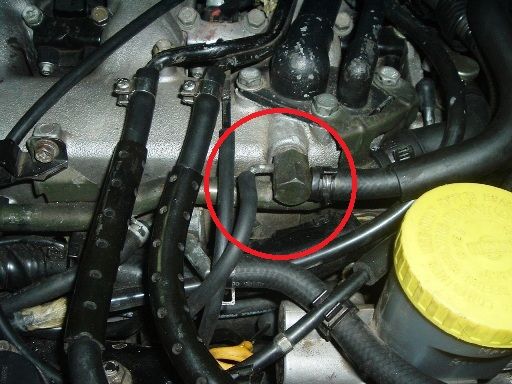
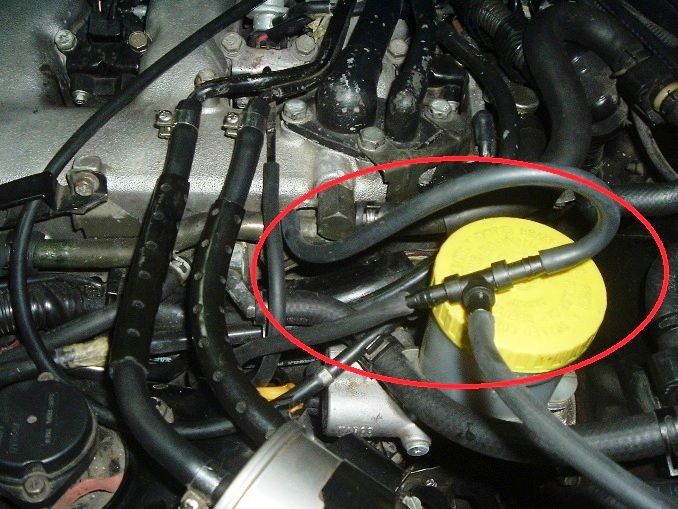
“T” connector installed with line running out under the good through the window opening. Watch that you don’t pinch the line in the door jam.
a href="http://s9.photobucket.com/user/wmasterson1/media/300zx%20Safety%20Boost/safety004_zps58f35f57.jpg.html" target="_blank">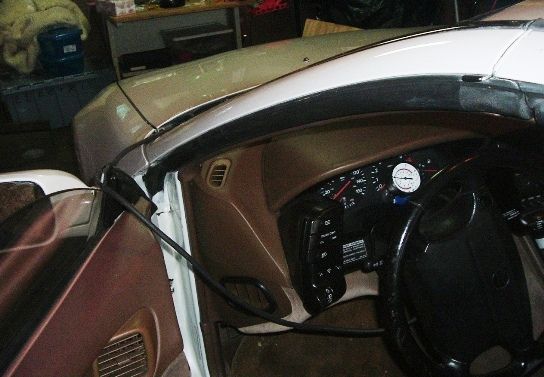
Vacuum line runs from the engine compartment to the interior and dash board.
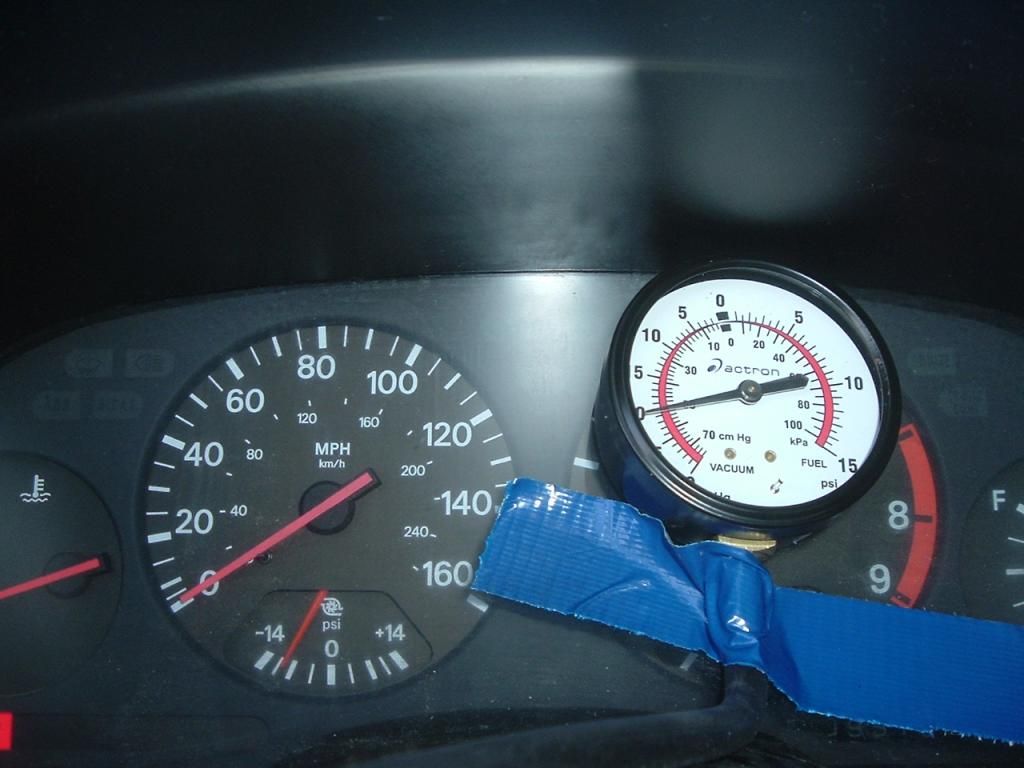
Above is a reading of -20 Hg at idle. Using the web page calculator this should translate into 9.82 PSI and it looks like the factory gauge is reading about -10 PSI but it is hard to tell exactly with the spacing for the markings used on the factory gauge. In any case it seems close but who can tell for sure?
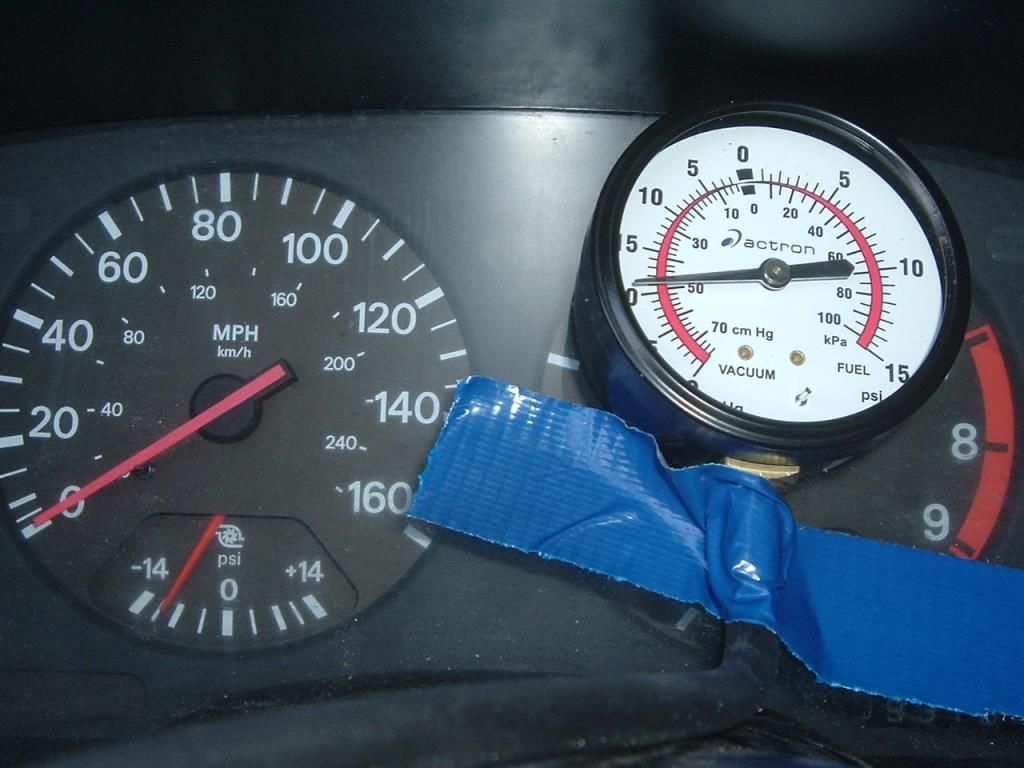 Above, the diagnostic gauge is reading -18.0 Hg and the factory gauge is still reading about -10 PSI. It should be reading -8.84 PSI by calculation so it should have changed from the preceding reading and it does not appear to have done so.
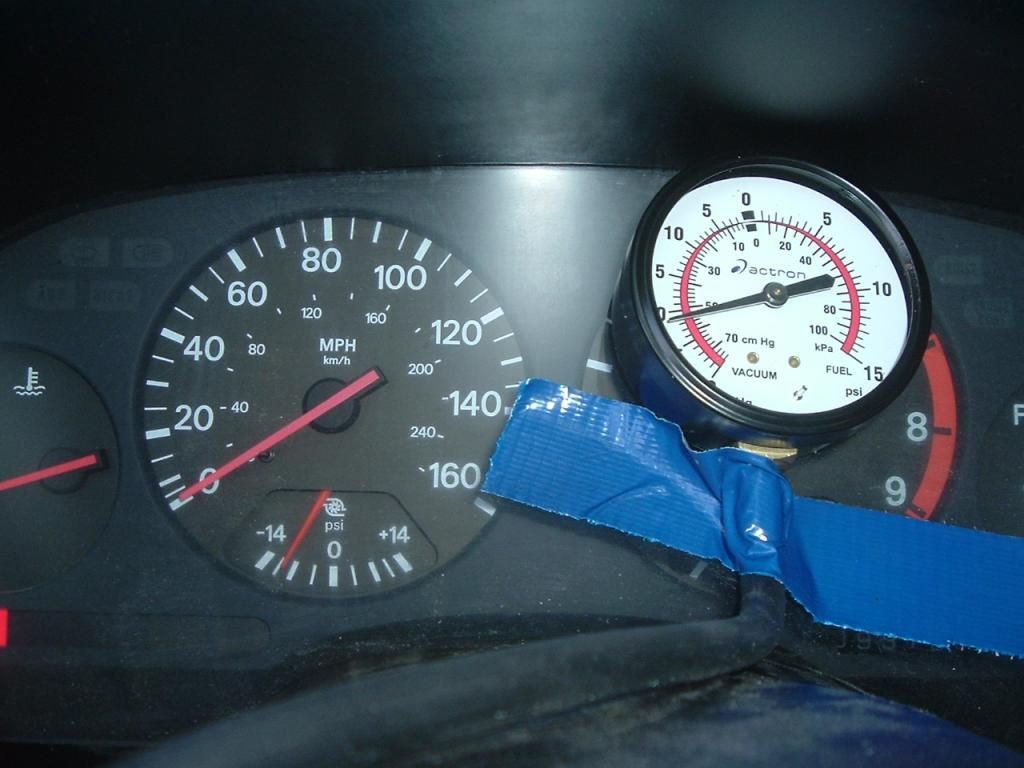
Above, the diagnostic gauge is reading -21Hg but the factory gauge is still reading -10. It should be reading -10.21PSI but appears to be in the same spot that it was for readings at – 18 Hg and -20Hg.
So thus far while the factory gauge is in the ball park, it is hard to read and does not react fast enough to vacuum changes so the movement of the meter cannot be used in the diagnosis of possible engine problems. Furthermore its accuracy does not appear to be as good as hoped for when compared to a commercially available vacuum gauge. What I was really interested in though, was the accuracy of the factory gauge in the positive direction, when it is actually measuring boost instead of vacuum
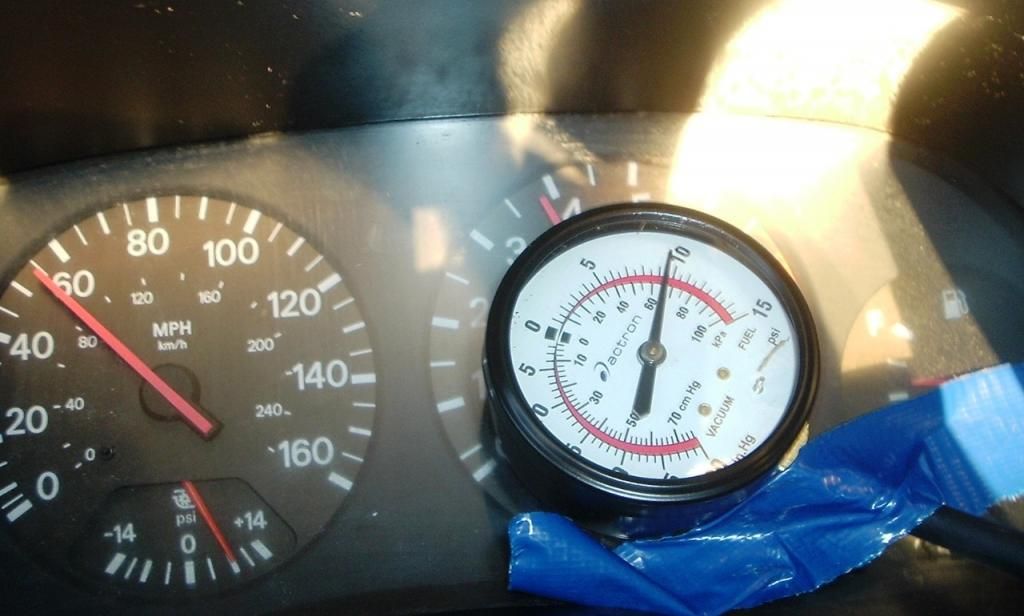
This picture above pretty much tells the story. The diagnostic vacuum / boost gauge is reading +9.5 PSI while the factory gauge is only showing + 7.0 PSI. In other words the factory gauge would indicate that I was in safety boost while the diagnostic gauge shows that I am getting the entire boost that a stock TT will generate. The moral of the tale is that if you think that you may be in safety boost because your boost gauge is only reading 6 or 7 lbs. PSI, the very first thing that you will want to do (instead of the last thing as in my case) is to verify the data with an easier to read and more accurate vacuum / boost gauge. This will save you time, money and aggravation and spare you from running around with your hair on fire trying to find the cause of a problem that does not actually exist. Yes, for those that are thinking it, I did compare the Actron meter with another vacuum meter to verify its readings. I like to use the Actron better however because the numbers in the positive range are just as large as those in the negative range. Most vacuum meters have the positive numbers in a smaller scale or off to the side somewhere and do not go as high. Safety Boost vs. Fail Safe I have seen the terms Fail Safe System and Safety Boost System used interchangeably in a number of posts. They are completely different systems. The Fail Safe system is a limp home mode that lets a driver start and get their car home if the ECU gives up the ghost. It is found on both the turbo and NA cars. The safety boost system is obviously only found on turbo cars and simply determines whether to allow the stock car the last two pound of boost or not. Causes of Safety boost The 1990 – 1994 FSM (1994 FSM EF & EC 30) lists 3 criteria that the ECM considers when deciding whether to allow full boost or not. In 1995 a fourth item was added to the FSM.
The three input readings are:
1. Camshaft Position Sensor
2. Throttle Position Sensor
3. Knock Senor
The 1995 FSM adds a fourth item:
4. Engine Coolant Sensor
The camshaft position sensor signal is used simply to tell the ECM that the engine is turning over. The throttle sensor position tells the ECM that the engine is off idle and the Knock Sensor tells the ECM that the engine is not knocking (which it might do if not using Premium fuel for instance) or if the ignition timing is too far advanced, or any number of other causes.
The engine temperature sensor tells the ECM the engine temperature which it uses to determine if the engine is above or below 131 degrees F. All four of these sensors have contacts that can become corroded or may have been unhooked during maintenance and never re-hooked up. Of course there could also be a break in the wire or the sensor itself could have gone bad. The FSM lists any number of tests that can be performed to check out the sensors. There is no sense in repeating them here. If you do not have a FSM, there is one on line with free access and it does not hound you for donations. [ http://www.300zx.co.uk/cgi-bin/manual.cgi ] The manual is of a UK / Australian version. Most of the readings in mm list inch equivalencies and there are actually only fairly small differences between the cars. In any case it is way better than nothing. Changes in the FSMs A change in this system occurred according to the FSM in 1994. In the 1990 – 1993 FSMs EF & EC 177 item 25, wastegate solenoid, implies that the potential boost is increased at 2000 RPMs. In the 1994 and newer FSMs the RPM figure is changed to 3000 RPMs. I have not tested this to see if the wastegate solenoid activation point actually changed or if it was originally listed incorrectly. Possible Errors in the FSM IMO, a possible error occurs in the listing for the Throttle Position Sensor in the FSM EF & EC 30. It lists a throttle position reading of “more than 0.1V” as being necessary for full boost. I believe that this may be a typo and it should possibly read “more than 1.0V” or in any case, a higher number than 0.1V instead. I say this because the TPS is set to read between .4V volt and .5V at idle so it would always be above 0.1V and that would make the input of little value since it would basically just tell the ECM the ignition key was turned on. On the other hand, a 1.0V reading with a maximum on 4.0V at full throttle would mean that the throttle pedal was significantly depressed and would mean that the engine operating at a speed at least above idle and at or headed for the 2000 RPM – 3000 RPM mark. This is estimation on my part. It is nothing that I can test for at the moment. I believe that there is an error in the 1995 FSM EF & EC30 in respect to the operation of the Engine Coolant Temperature Sensor as well. The FSM implies that the ECM will allow full boost if the engine temperature is “less than 56 degrees C (131 degrees F)” I believe this should read: greater than 56 degrees C (131 degrees F). Knock Sensor A final note should be made relative to the Knock (detonation) sensor and safety boost. If your engine is knocking, and it is not because you put in low octane fuel, you have more to worry about than whether you are getting the last 2 pounds of boost or not. The ECM does more than cut boost when knocking is detected. It starts retarding the ignition timing (1994 FSM EF & EC 22) of the engine until the knock ceases. If the knock goes away then theoretically the engine could come out of safety boost but still will not operate correctly because the timing is being kept retarded. If you are in safety boost and are not using poor gas and the ECU is not throwing off a knock sensor error code, then it is not probable that the knock sensor is the cause of your safety boost problem. Either way, if the engine is in fact knocking, unchecked, the knocking will eventually destroy the engine. So you should forget all about safety boost until the source of the knocking is cured and the last thing that you would want to do is to bypass the knock sensor as some internet bloggers have suggested. Corrections or suggestions for improvement are welcome. Hope this saves some people aggravation.
|

